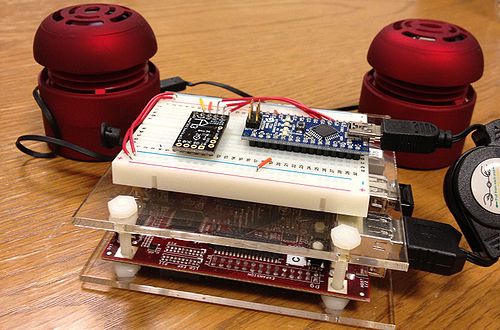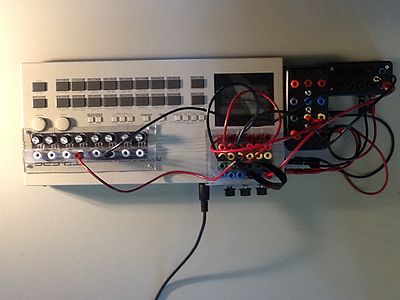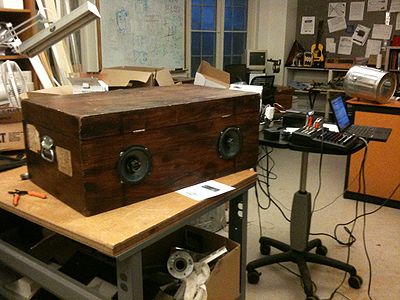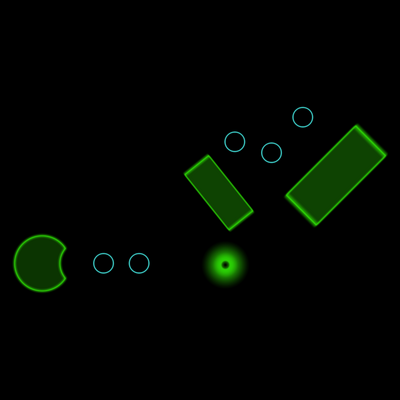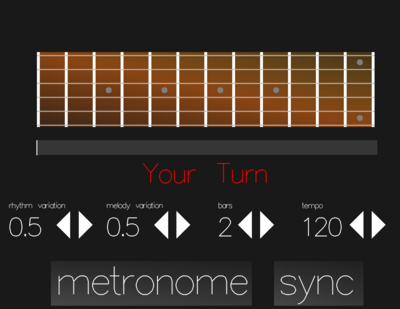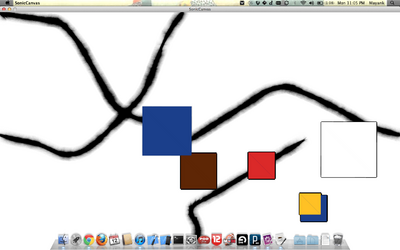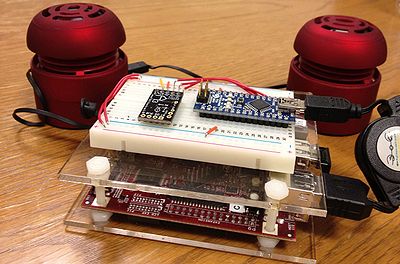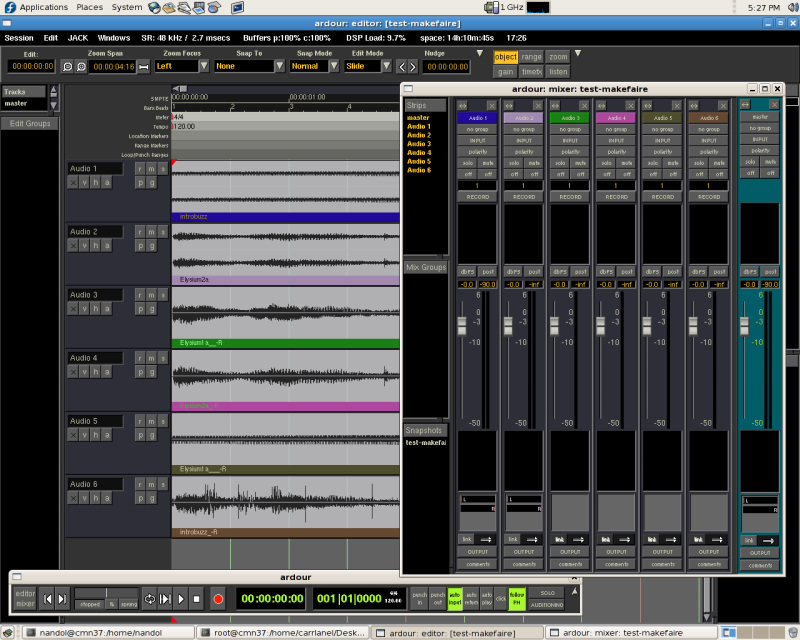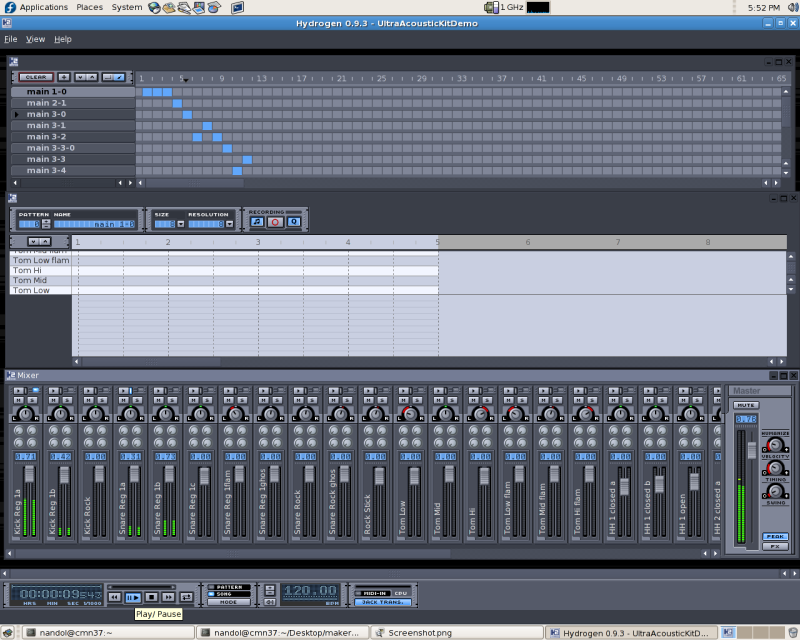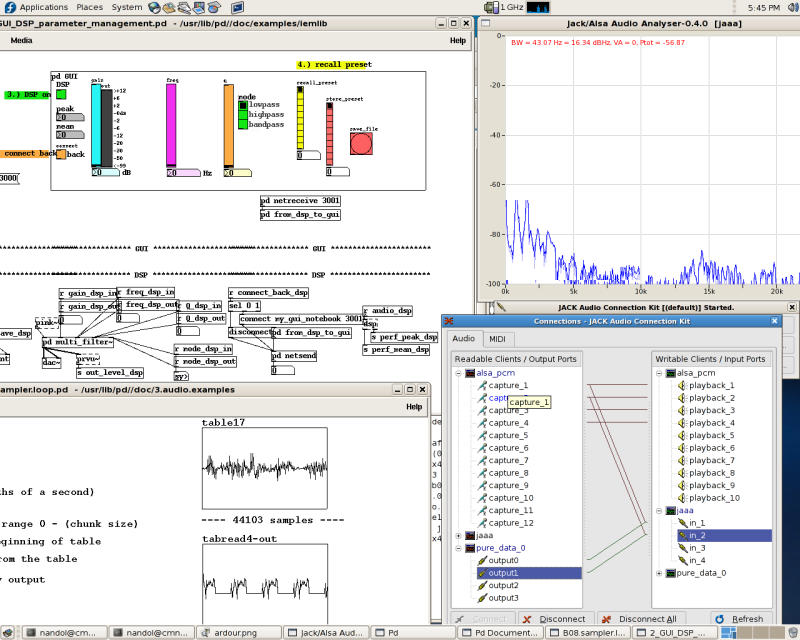MakerFaire
Contents
Introduction
The Center for Computer Research in Music and Acoustics (CCRMA -- pronounced "karma") is an interdisciplinary center at Stanford University dedicated to artistic and technical innovation at the intersection of music and technology. We are a place where musicians, engineers, computer scientists, designers, and researchers in HCI and psychology get together to develop technologies and make art. In recent years, the question of how we interact physically with electronic music technologies has fostered a growing new area of research that we call Physical Interaction Design for Music. We emphasize practice-based research, using DIY physical prototying with low-cost and open source tools to develop new ways of making and interacting with sound. At the Maker Faire, we will demonstrate the low-cost hardware prototyping kits and our customized open source Linux software distribution that we use to develop new sonic interactions, as well as some exciting projects that have been developed using these tools. Below you will find photos and descriptions of the projects and tools we will demonstrate.
Circuit Explorer
Kurt Werner
Circuit Explorer is an audio-visual installation that allows participants to explore electronic circuits and algorithmic sound and video generation processes in a hands-on way. Participants can attach probes from a bank of four oscillators to a broken electronic device to produce sounds. The audio that the oscillators produce will be input into a computer running MaxMSP/Jitter. This audio will be analyzed by the patch and used to drive "glitch" video generation / processing. A combination of the original sounds and sounds synthesized from analysis of the video will be processed and sent out of the speakers.
Busk Box
Sasha Leitman
The Busk Box is a street performance system that combines the traditions of wandering street performers and musicians with the modern technologies. Inside of a 1911 wooden trunk, 2 6" speakers, 1 10" subwoofer, 2 class-T amplifiers and a portable mixer are all powered by lithium-ion batteries. In addition, the box is supported by folding wheels and legs which enable the box to be set up and torn down in less than 3 minutes. This platform was designed to bring experimental and electronic music to the San Francisco Fisherman's Wharf district.
The Sinkapater
Jiffer Harriman
The Sinkapater is an untethered beat sequencer. By allowing different tracks to divide the beat arbitrarily complex polyrhythms can be created. By allowing loop at different loop lengths, patterns unfold over long periods of time. By visualizing beats as falling water drops, gain new perspective on these patterns.
tulpasynth
Colin Sullivan
"tulpasynth" is a collaborative music system that enables a group of people to spontaneously compose together by manipulating objects on a touchscreen interface. Each user uses her/his own touchscreen interface to interact with the objects on a shared canvas that is synchronized in real-time across all of the screens. The client is implemented as an iPad app which is built on top of OpenGL and the Box2D physics engine. Sounds are synthesized from scratch on each device using The Synthesis Toolkit in C++ (STK). The Node.js server synchronizes each client over a socket connection. The system is titled “tulpasynth” in the spirit of creation without boundaries.
Miles Ahead
Mayank Sanganeria
Miles Ahead is an interactive improvisation system that allows you to sync up with any backing track that you like and start 'jamming' with the computer using MIDI instruments. The computer listens to what you played and trades 4's (or 8's or n's) with you, playing off of what you played and hence allows you to take your improvisational ideas to previously unexplored places.
Soundshape
Mayank Sanganeria
Soundshape is an app for the iPad that allows you to create shapes and sounds by drawing and recording. You can move these shapes around, cut these shapes, loop them, scrub through them and hence make music using these shapes. Check online for an inventory of these sonic shapes and even add your own. (The graphics on this app is going to be revamped - unsure how but it has to and will look better)
Sonic Canvas
Mayank Sanganeria
Sonic Canvas is a Processing app that uses inputs from the iPhone and your voice to make a painting. There are also sonic objects (your recorded voice) on the screen that sound when the 'paintbrush' moves over it and it applies certain effects on the sound clips.
Satellite CCRMA
Ed Berdahl, Wendy Ju Satellite CCRMA promotes rapid prototyping of new media. Used by artists and engineers alike, Satellite CCRMA integrates together open-source software and hardware projects. Most importantly, it comes with examples that make it possible for new users to get up and running within a matter of minutes. For more info, please see https://ccrma.stanford.edu/~eberdahl/Satellite/
Software Tools
Planet CCRMA at Home is a collection of open source programs that you can add to a computer running Fedora Linux to transform it into an audio/multi-media workstation with a low-latency kernel, current audio drivers and a nice set of music, midi, audio and video applications (with an emphasis on real-time performance). It replicates most of the Linux environment we have been using for years here at CCRMA for our daily work in audio and computer music production and research. Planet CCRMA is easy to install and maintain, and can be upgraded from our repository over the web. Bootable CD and DVD install images are also available. This software is free.
http://ccrma.stanford.edu/planetccrma/software
Ardour - Multitrack Sound Editor
Hydrogen - Drum Sequencer
Pd, Jack and Jaaa - Real-time audio tools
